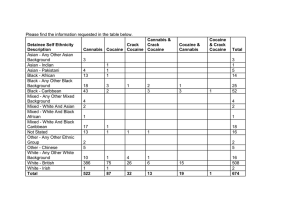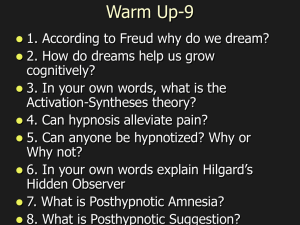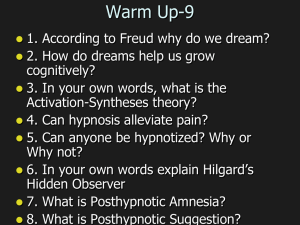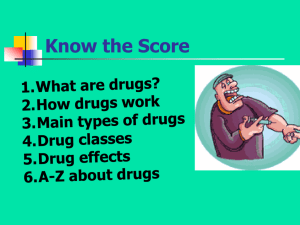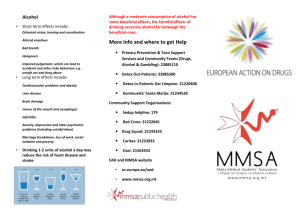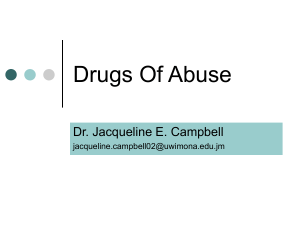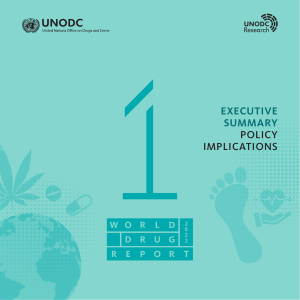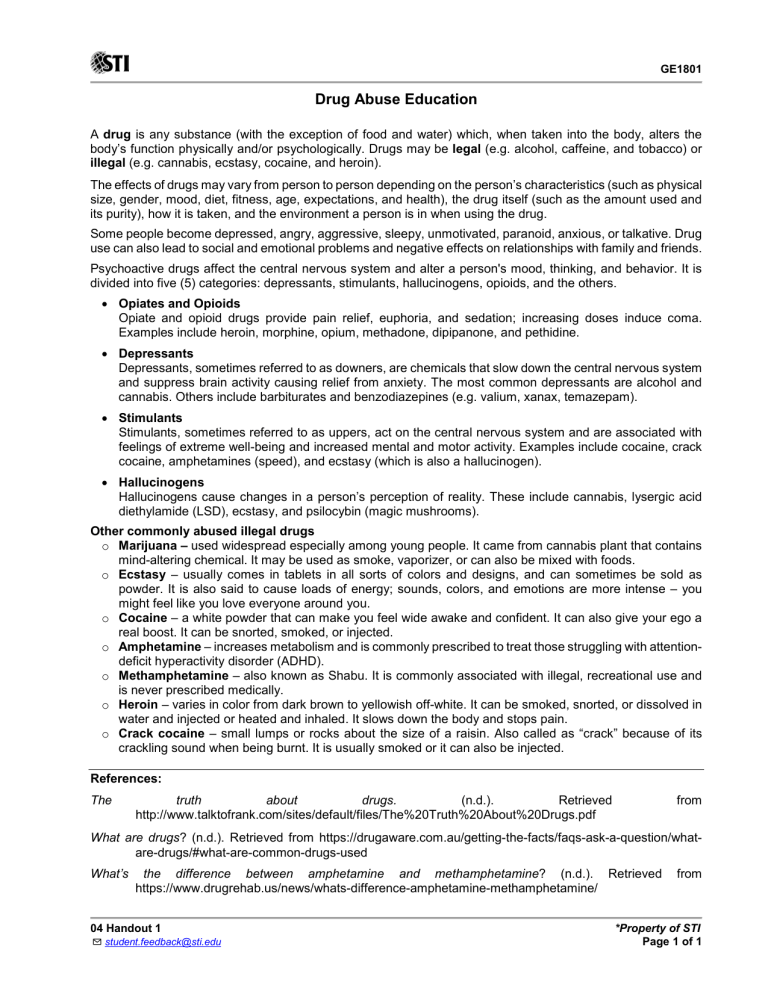
GE1801 Drug Abuse Education A drug is any substance (with the exception of food and water) which, when taken into the body, alters the body’s function physically and/or psychologically. Drugs may be legal (e.g. alcohol, caffeine, and tobacco) or illegal (e.g. cannabis, ecstasy, cocaine, and heroin). The effects of drugs may vary from person to person depending on the person’s characteristics (such as physical size, gender, mood, diet, fitness, age, expectations, and health), the drug itself (such as the amount used and its purity), how it is taken, and the environment a person is in when using the drug. Some people become depressed, angry, aggressive, sleepy, unmotivated, paranoid, anxious, or talkative. Drug use can also lead to social and emotional problems and negative effects on relationships with family and friends. Psychoactive drugs affect the central nervous system and alter a person's mood, thinking, and behavior. It is divided into five (5) categories: depressants, stimulants, hallucinogens, opioids, and the others. • Opiates and Opioids Opiate and opioid drugs provide pain relief, euphoria, and sedation; increasing doses induce coma. Examples include heroin, morphine, opium, methadone, dipipanone, and pethidine. • Depressants Depressants, sometimes referred to as downers, are chemicals that slow down the central nervous system and suppress brain activity causing relief from anxiety. The most common depressants are alcohol and cannabis. Others include barbiturates and benzodiazepines (e.g. valium, xanax, temazepam). • Stimulants Stimulants, sometimes referred to as uppers, act on the central nervous system and are associated with feelings of extreme well-being and increased mental and motor activity. Examples include cocaine, crack cocaine, amphetamines (speed), and ecstasy (which is also a hallucinogen). • Hallucinogens Hallucinogens cause changes in a person’s perception of reality. These include cannabis, lysergic acid diethylamide (LSD), ecstasy, and psilocybin (magic mushrooms). Other commonly abused illegal drugs o Marijuana – used widespread especially among young people. It came from cannabis plant that contains mind-altering chemical. It may be used as smoke, vaporizer, or can also be mixed with foods. o Ecstasy – usually comes in tablets in all sorts of colors and designs, and can sometimes be sold as powder. It is also said to cause loads of energy; sounds, colors, and emotions are more intense – you might feel like you love everyone around you. o Cocaine – a white powder that can make you feel wide awake and confident. It can also give your ego a real boost. It can be snorted, smoked, or injected. o Amphetamine – increases metabolism and is commonly prescribed to treat those struggling with attentiondeficit hyperactivity disorder (ADHD). o Methamphetamine – also known as Shabu. It is commonly associated with illegal, recreational use and is never prescribed medically. o Heroin – varies in color from dark brown to yellowish off-white. It can be smoked, snorted, or dissolved in water and injected or heated and inhaled. It slows down the body and stops pain. o Crack cocaine – small lumps or rocks about the size of a raisin. Also called as “crack” because of its crackling sound when being burnt. It is usually smoked or it can also be injected. References: The truth about drugs. (n.d.). Retrieved http://www.talktofrank.com/sites/default/files/The%20Truth%20About%20Drugs.pdf from What are drugs? (n.d.). Retrieved from https://drugaware.com.au/getting-the-facts/faqs-ask-a-question/whatare-drugs/#what-are-common-drugs-used What’s the difference between amphetamine and methamphetamine? (n.d.). Retrieved https://www.drugrehab.us/news/whats-difference-amphetamine-methamphetamine/ 04 Handout 1 ✉ student.feedback@sti.edu from *Property of STI Page 1 of 1


